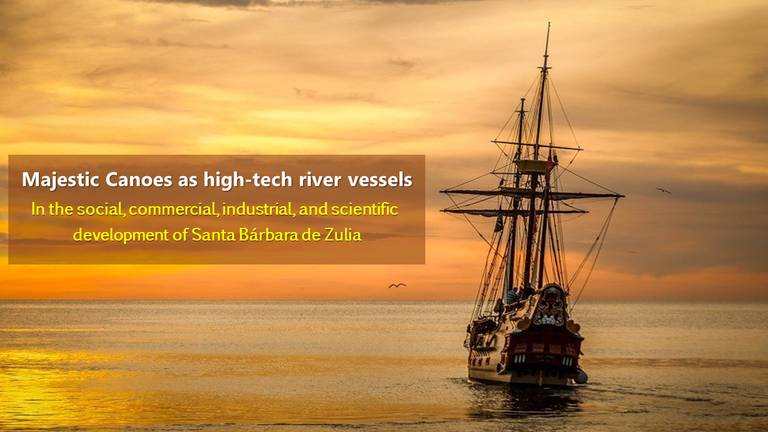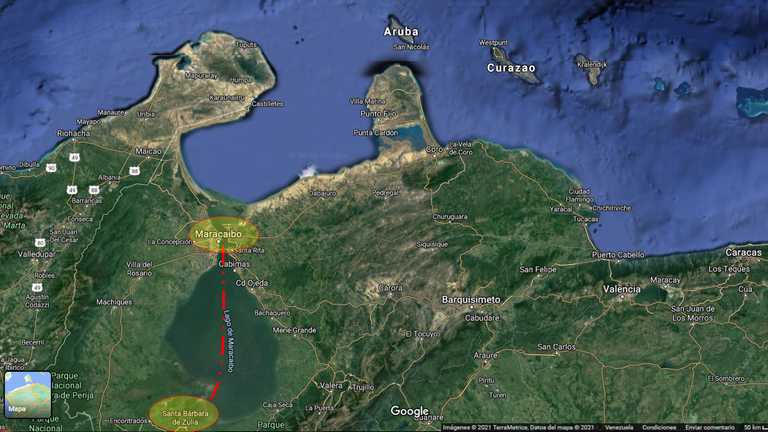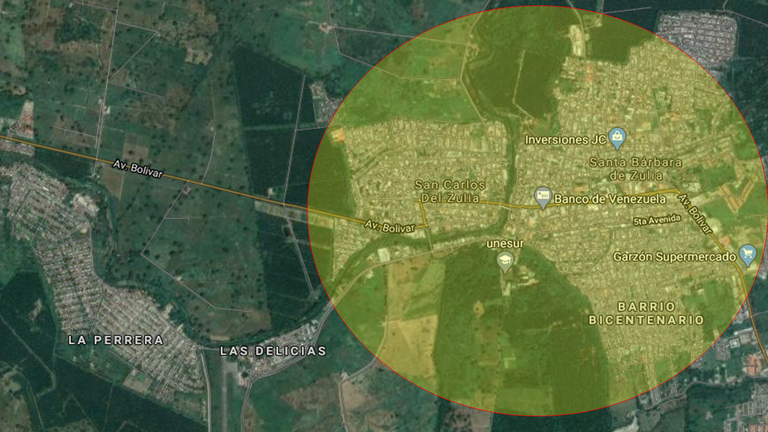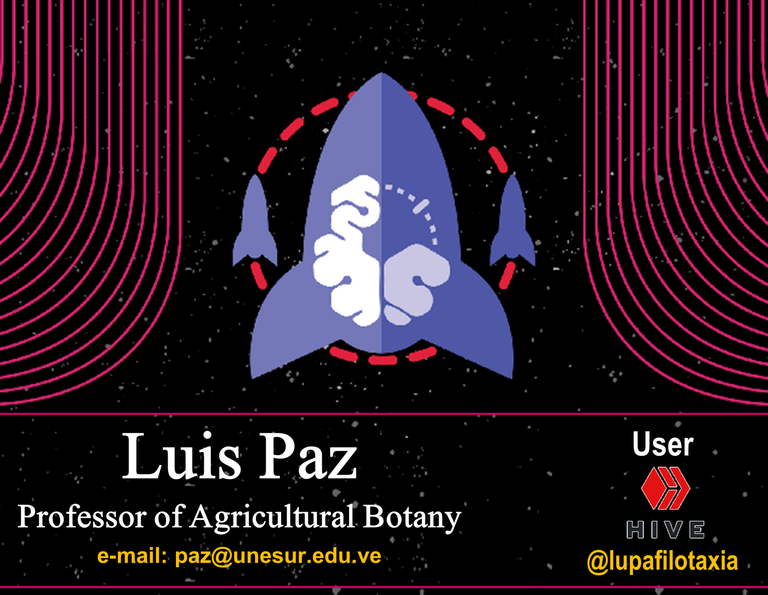
For those who have not yet heard of Santa Bárbara de Zulia, it is a city in Venezuela located in the extreme west of the country, specifically in the southern sub-region of Lake Maracaibo, a region historically characterized by its extensive history of livestock and agricultural production, mainly of the items Banana, Cambur, Sugar Cane, Corn Oil Palm, Cassava, Patchita, Cocoa Porcelain, Milk, Guava, Loquat, among other fruit trees of equal or greater economic and nutritional importance.
In the collective imagination of those of us who currently live in Santa Bárbara de Zulia, sailing in Steam engine Canoes is a symbolic reference that promoted the development of our region. During the first 60 years of the 20th century, this means of transport represented the greatest technological advance in river transport for the south of the lake, since it allowed the transfer of cargo and passengers by connecting the Escalante River with Lake Maracaibo.

Fig. 2 River and lake route of the canoes from Santa Bárbara to Maracaibo and vice versa. The image was designed by the author: @lupafilotaxia, incorporating in the background Image taken from Google Maps

In the field of river navigation, the canoes were elaborated and perfected with state-of-the-art technology, with the purpose of facilitating navigation in shallow water bodies, hence, in Venezuela the construction of these vessels with steam engines (external combustion engine, with technology to transform the thermal energy of a quantity of water into mechanical energy), wooden structure and in the form of a sail, had the objective of creating economic dynamism in those regions of the country that had no land connection, neither by road nor by rail.
The importance that the canoes had in connecting the inhabitants of our prodigious Santa Barbara de Zulia with Maracaibo, the current capital of the state of Zulia, in addition to the exchange of agricultural goods, was the arrival of men and women who began buying land on the banks of the Escalante River, and decided to undertake and build large commercial establishments that helped the economic development of our sub-region.

Fig. 3 The motorized dugout canoe promoted the development of Santa Bárbara de Zulia. The image was designed by the author: @lupafilotaxia, incorporating in the background Image taken from Google Maps

✔ The cover image was designed by the author: @lupafilotaxia, incorporating the public domain image background: Pixabay, 2014

Original manuscript, uploaded from the Project HOPE community website

The arrival of the canoes to our shores, from the social, commercial, industrial, scientific and technological points of view, meant the beginning of the historical evolution of Santa Bárbara de Zulia, to the point in which many indigenous people in a nomadic condition, decided to settle down definitively near the margins of the river port, which triggered the strengthening and the political territorial division of the region, to later constitute the figures of municipalities and parishes, later and in a progressive way to create centers of primary and secondary education, centers of health, governmental institutions, and most important the construction of highways, and the raising of infrastructures for the processing and industrialization of the Milk, Meat, Flour, Oil, Juices and Sweets.
At present, Santa Bárbara de Zulia is the most populated, modern city and the one of greater influence of the agricultural, cattle and agro-industrial sector of Venezuela, to the point of being catalogued like the Pantry of Venezuela,its vertiginous development has been unstoppable, and to the date it counts on a university system of vanguard, being the National Experimental South University of the Lake "Jesus Maria Semprum" its icon and route for its technological scientific development.

I love these lands and all their splendor, as much as I love my family.
OBSERVATION


This post has been manually curated by @bala41288 from Indiaunited community. Join us on our Discord Server.
Do you know that you can earn a passive income by delegating to @indiaunited. We share 80 % of the curation rewards with the delegators.
Here are some handy links for delegations: 100HP, 250HP, 500HP, 1000HP.
Read our latest announcement post to get more information.
Please contribute to the community by upvoting this comment and posts made by @indiaunited.
Thank you very much for your support.
Greetings dear teacher @lupafilotaxia.
As usual another great content that you share with us in this occasion, totally certain what you express about this wonderful boats like the Canoes, where, it is important to emphasize what it expresses:
Santa Bárbara de Zulia, a beautiful and welcoming region and all the people who live there can give testimony of what was expressed, and also highlight the great leap in development in all senses, where, we must place as a spearhead to our maximum house of study as it is the National Experimental University South the Lake "Jesus Maria Semprum".
Thank you professor for sharing such extraordinary content with all of us. Successes.
Best regards @rbalzan79
Without a doubt, our region is a blessed and prodigious land, creator of life. Its people, and its agricultural and agro-industrial potential, are blessings that our wonderful Santa Bárabara de Zulia has received. Thank you for your visit.
Hello @lupafilotaxia
This is an excellent post. It really is.
You have done a great job with all the images, it is very easy to visualize what you are talking about. It is a clear example of how technology impacts positively on a location.
And also how it can guide the organization of civilizations from the economic, and from the technological.
Best regards @josevas217
Historically, population growth and the economic, industrial and scientific development of large cities have been marked by the incorporation of technological tools, and in the case of Santa Bárbara de Zulia, steam-engineered vessels have meant the implementation of an exponential technological development. Thank you for leaving your comment.
There is no doubt that for any population located at the shore of a lake, boats play a fundamental role in its growth and development, especially this region of Zulia. And this is how technology has also influenced the organization of the population. Greetings friend @lupafilotaxia.
Correct friend @emiliomoron, it is a privilege for any population to have a geographical location that has a lake nearby, in our case it meant being able to connect with the capital of the state of Zulia, an element that made possible the development in all senses in Santa Barbara de Zulia. Thank you for leaving your comment.
hi @lupafilotaxia
I did not know that this city existed and that it had such a beautiful history, I will write it down in my long list of places to visit some day, it must be exciting to be in those canoes
I hope to be your guide, so that I can show you these prodigious lands, bathed by our imposing Lake Maracaibo. Warm greetings friend @ramsesuchiha, I hope you are well, we continue reading.
A golden age was when canoes were used for commercial communication between the city of Santa Bárbara de Zulia and the state capital, Maracaibo. This technology contributed enormously to the development of the region. Greetings and thanks for sharing @lupafilotaxia.
Greetings dear friend and professor @carlos84, I fully agree with you, that golden age marked the beginning of growth and development of this entire sub-region of the South of Lake Maracaibo.